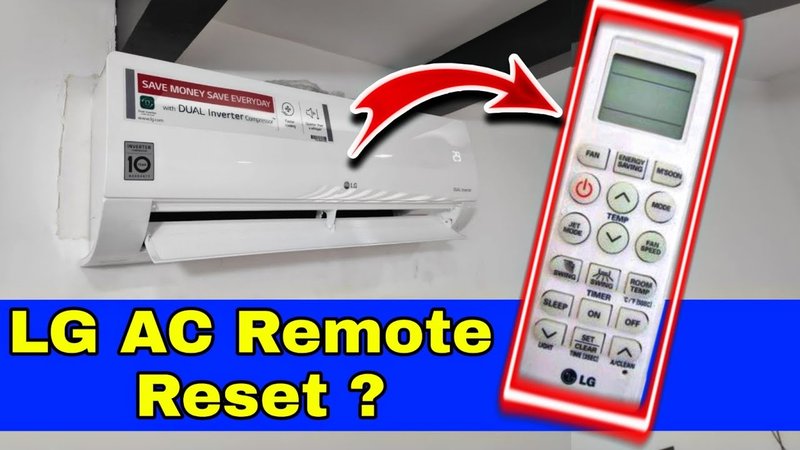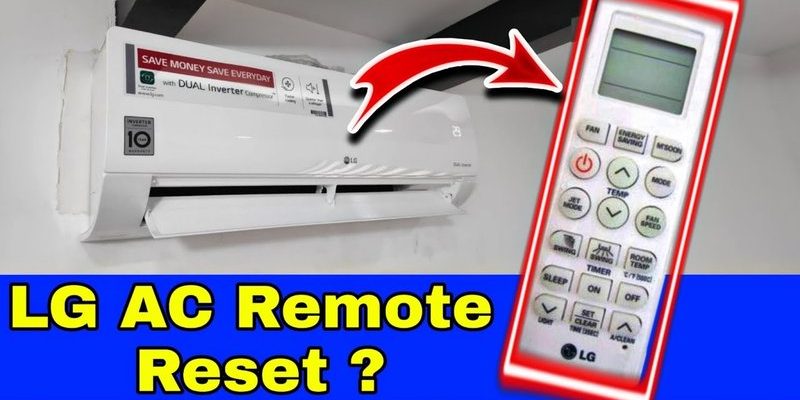
Let me tell you, cloning an LG AC remote isn’t quite like copying files on your laptop. These little gadgets use IR (infrared) codes that need to match what your AC expects. And if you’ve ever accidentally grabbed the wrong remote and wondered why pressing “Power” makes nothing happen, that’s why. But—good news! While it’s not magic, with the right approach, you can actually clone your LG AC remote and pair it with your new unit. Let’s break it down slow, plain, and super beginner-friendly, so you can get back to chilling (literally).
Understanding LG AC Remotes: More Than Just Buttons
Before we even think about hitting any buttons or entering secret codes, it helps to understand what an LG AC remote really is. At its core, this remote is like a tiny flashlight, but instead of regular light, it flashes invisible signals (IR codes) that your air conditioner understands. Different models might use slightly different “languages” (a.k.a. codes), which is why one remote might not always work on another AC, even if they both have the LG logo.
There are typically two remote types:
- Original (OEM) Remotes: These come with your air conditioner and are pre-programmed for your unit. They’re reliable, but if they break or get lost, replacements can be expensive or hard to find.
- Universal AC Remotes: These are designed to be programmable. Most can be “taught” the right code so they mimic your original, but sometimes the process is fussier.
So, when people talk about “cloning” an LG AC remote, they’re usually using a universal remote that can copy the IR code from the original. Not every remote supports this, but many new universal remotes do. If you’re ever standing in an electronics store, squinting at remote packaging, look for phrases like “learning function,” “code copy,” or “clone support.”
What Does ‘Cloning’ a Remote Actually Mean?
Let me explain it with a story: Imagine you have a friend who always knows your coffee order. If you move away and get a new barista, wouldn’t it be awesome if your old friend could magically transfer their knowledge to the new one? That’s exactly what cloning is for remotes—it lets your new remote “learn” how to talk to your AC by copying the exact code signals.
Here’s the thing: Some remotes have a dedicated “learning” mode. In this mode, they can listen for the button signal from your original remote and save it. When you press a button on the clone, it sends the exact same code, so your AC thinks it’s the original. On the flip side, fixed code remotes (the ones that don’t support learning) can only use pre-set codes, which may or may not match your AC unit.
The big takeaway? Only universal remotes with a learning feature or “clone” button can truly clone an LG AC remote. If your remote doesn’t have this, you’ll need to pair it using codes from the manual—less fancy, but it’ll still get the job done.
What You Need Before You Start
If you’re ready to jump in, pause for just a second and check your gear. Here’s what you’ll want handy:
- The original LG AC remote (if you have it—it’s not 100% necessary, but it helps a lot)
- A universal remote with learning or clone capability (look for those keywords!)
- Fresh batteries in both remotes—seriously, don’t skip this. Weak batteries can mess up the cloning process or stop the remotes from pairing properly
- Your LG air conditioner unit, plugged in and within sight
- Patience. I wish I could promise “done in 30 seconds!” but sometimes it takes a couple of tries, especially if the codes don’t sync right away
If your old remote is gone or broken, don’t worry! Most universal remotes let you set them up by entering a code directly or running an auto-pairing scan. Just have your model number nearby.
Step-by-Step: How To Clone an LG AC Remote
Alright, the moment of truth! Here’s how you typically clone an LG AC remote to a universal remote (with cloning function). I’ll lay this out as visually as possible, so you can imagine each step:
- Put both remotes on a flat surface, facing each other (about 2–5 cm apart, sensor to sensor). This is crucial—the sensors talk like two people having a quiet conversation. If they’re too far apart, the signal gets lost.
- On the universal remote, press and hold the “Learning” or “Clone” button. This might be labeled as “LEARN,” “SET,” or even just a blank button. Hold it for about 3–5 seconds until an LED blinks, which means it’s in learning mode.
- Press the button on the universal remote you want to copy, like “Power.” The LED usually stays on or blinks slowly to show it’s waiting for input.
- On your original LG remote, press and hold the “Power” button (or whichever button you want to clone). Hold it until the universal remote’s LED flashes quickly or turns off—this means it’s learned the code.
- Repeat for other buttons you want to clone—”Temp +,” “Fan,” “Mode,” and so on.
- When you’re done, press the “Learning” button again to exit learning mode.
- Test your new remote on the LG AC unit. If it turns on, changes temp, and beeps just like your original, congrats—success!
Don’t worry if it doesn’t work the first time. Sometimes the code can get scrambled if you press buttons too quickly or if there’s interference. Double-check the batteries and try again.
How to Pair a Universal Remote Without Cloning
So, what if you don’t have the original LG remote to clone, or your universal remote doesn’t support learning? You can still pair it by entering the right code. Here’s how that goes:
- Find the model number of your LG AC (usually on a sticker on the side or bottom).
- Check the manual for your universal remote. There’s often a code list for LG air conditioners. If you lost the manual (happens to the best of us), google your remote model plus “code list.”
- Enter the pairing mode. Normally, this means holding down the “Set” or “Code” button until an LED lights up.
- Input the code for LG AC units (e.g., 025, 231, 512, etc.).
- Press “Power” or another button to test if the code works. If nothing happens, try the next code from the list.
If none of the codes work, many remotes have an “auto-search” function. Just point it at your AC, press “Search,” and it’ll cycle through codes until your AC responds. Sometimes it takes a few minutes, but it’s worth the wait.
Pro tip: Universal remotes usually can’t clone “smart features” like Wi-Fi control or app syncing, but for basic functions—on/off, temp, fan—it’s perfectly reliable.
Troubleshooting Common Cloning and Pairing Problems
Honestly, this is where most folks get tripped up. The process sounds simple, but electronics love to throw curveballs. Here are the top headaches and how to fix them:
- Remote Not Responding: Check your batteries (again!), double-check if you’re in learning mode, and make sure the sensors face each other closely.
- Wrong Code or Partial Function: If some buttons work but others don’t, try re-learning just the problem buttons. For code-based universal remotes, try the next code in the list; not all codes cover every feature.
- LED Not Flashing: On most remotes, the flashing LED is your sign the remote is ready. If nothing lights up, sometimes a battery reset (remove and re-insert batteries) or waiting 10 seconds does the trick.
- AC Unit Doesn’t React: Make sure the AC is plugged in, on standby, and not locked in a special mode. Sometimes resetting the AC (turning the power off and on) helps sync things up.
And if all else fails? Sometimes you’ve just got a stubborn remote or a very new/very old LG AC model. Thankfully, most modern universal remotes have firmware updates or community forums online—definitely worth a look.
When Should You Reset or Re-Sync Your Remote?
Let’s say everything was working, then suddenly, poof—your new remote stops controlling your LG AC. What gives? Here’s the deal: remotes can lose their codes after a battery change, a power surge, or for seemingly no reason at all. It’s like your favorite playlist disappearing from your phone—frustrating but fixable.
To reset, look for a tiny reset hole (sometimes you’ll need a paperclip) or follow your remote’s manual for the “reset” sequence. After resetting, you’ll need to re-clone or re-pair your remote as we covered above. If your AC unit has a reset or pair button (rare, but some do), you can use that to help sync everything up.
If you’re constantly losing your remote’s code, consider replacing the batteries with name-brand ones and avoid mixing old and new batteries. The little things really do matter!
Universal Remote vs. Original LG Remote: Which Is Better?
Here’s where some folks get opinionated, and I’ll admit—I’ve got thoughts too. An original LG remote is always the smoothest option for perfect compatibility. Every button will work, and there’s no fussing with codes or learning. But if you lose it, finding an exact replacement can be frustrating, and prices can be steep.
On the other hand, a universal remote with cloning or code support is way more flexible. You can use it for future ACs, other brands, or even your TV. You might lose a few “fancy” features, but the basics (on/off, temp, fan) are covered. Plus, if you ever switch to a different AC brand, you won’t have to buy yet another remote.
Think of it like shoes: the ones that came with your suit fit perfectly, but a comfy all-purpose sneaker works just fine for everyday use.
Tips for Long-Term Use and Maintenance
Remote controls are often treated like TV snacks—left on tables, stuck in couch cushions, and dropped one too many times. To keep your LG AC remote (original or cloned) working for years:
- Change the batteries once a year, before they start to fade.
- Keep the sensor window clean. Dust can block the IR beam, just like dirty sunglasses blur your vision.
- Store remotes away from direct sunlight or extreme heat; those plastic buttons can get brittle over time.
- If you’re using a universal remote, keep the manual or a note with your AC code tucked in the battery compartment. Future you will thank you the next time a reset is needed.
And, if you ever need to clone a remote again? You’ll be the expert in your friend group—the person people text when their new AC refuses to listen to anyone.
Final Thoughts: Chilling Out with Your Cloned LG AC Remote
Figuring out how to clone an LG AC remote to a new unit can feel a bit like solving a puzzle, but it’s honestly not as complicated as it sounds once you know the process. Whether you’re using a high-tech universal remote with learning powers, or patiently pairing codes one by one, you’re unlocking a pretty nifty piece of tech magic right in your living room. The whole process is about making your life a little more comfortable—so don’t sweat any hiccups or mix-ups along the way.
If you ever get stuck, remember: fresh batteries, sensors lined up, and a dose of patience are your best friends. Soon enough, your new AC unit will be following your command, just like the old one—and you can get back to powering up, cooling down, and chilling out again.
